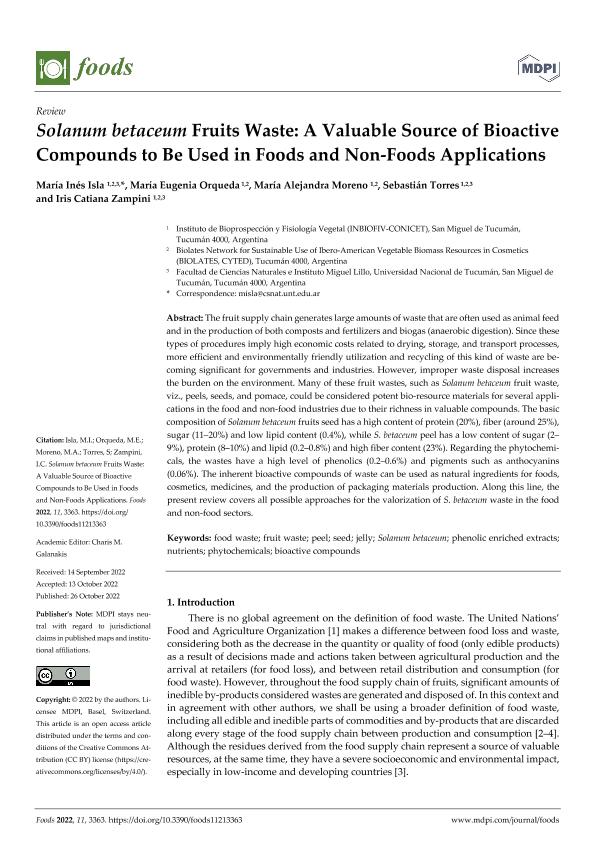Mostrar el registro sencillo del ítem
dc.contributor.author
Isla, Maria Ines

dc.contributor.author
Orqueda, Maria Eugenia

dc.contributor.author
Moreno, María Alejandra

dc.contributor.author
Torres, Sebastián

dc.contributor.author
Zampini, Iris Catiana

dc.date.available
2023-11-13T12:29:47Z
dc.date.issued
2022-10
dc.identifier.citation
Isla, Maria Ines; Orqueda, Maria Eugenia; Moreno, María Alejandra; Torres, Sebastián; Zampini, Iris Catiana; Solanum betaceum Fruits Waste: A Valuable Source of Bioactive Compounds to Be Used in Foods and Non-Foods Applications; MDPI; Foods; 11; 21; 10-2022; 1-18
dc.identifier.issn
2304-8158
dc.identifier.uri
http://hdl.handle.net/11336/217851
dc.description.abstract
The fruit supply chain generates large amounts of waste that are often used as animal feed and in the production of both composts and fertilizers and biogas (anaerobic digestion). Since these types of procedures imply high economic costs related to drying, storage, and transport processes, more efficient and environmentally friendly utilization and recycling of this kind of waste are becoming significant for governments and industries. However, improper waste disposal increases the burden on the environment. Many of these fruit wastes, such as Solanum betaceum fruit waste, viz., peels, seeds, and pomace, could be considered potent bio-resource materials for several applications in the food and non-food industries due to their richness in valuable compounds. The basic composition of Solanum betaceum fruits seed has a high content of protein (20%), fiber (around 25%), sugar (11–20%) and low lipid content (0.4%), while S. betaceum peel has a low content of sugar (2–9%), protein (8–10%) and lipid (0.2–0.8%) and high fiber content (23%). Regarding the phytochemicals, the wastes have a high level of phenolics (0.2–0.6%) and pigments such as anthocyanins (0.06%). The inherent bioactive compounds of waste can be used as natural ingredients for foods, cosmetics, medicines, and the production of packaging materials production. Along this line, the present review covers all possible approaches for the valorization of S. betaceum waste in the food and non-food sectors.
dc.format
application/pdf
dc.language.iso
eng
dc.publisher
MDPI
dc.rights
info:eu-repo/semantics/openAccess
dc.rights.uri
https://creativecommons.org/licenses/by/2.5/ar/
dc.subject
BIOACTIVE COMPOUNDS
dc.subject
FOOD WASTE
dc.subject
FRUIT WASTE
dc.subject
JELLY
dc.subject
NUTRIENTS
dc.subject
PEEL
dc.subject
PHENOLIC ENRICHED EXTRACTS
dc.subject
PHYTOCHEMICALS
dc.subject
SEED
dc.subject
SOLANUM BETACEUM
dc.subject.classification
Otros Tópicos Biológicos

dc.subject.classification
Ciencias Biológicas

dc.subject.classification
CIENCIAS NATURALES Y EXACTAS

dc.title
Solanum betaceum Fruits Waste: A Valuable Source of Bioactive Compounds to Be Used in Foods and Non-Foods Applications
dc.type
info:eu-repo/semantics/article
dc.type
info:ar-repo/semantics/artículo
dc.type
info:eu-repo/semantics/publishedVersion
dc.date.updated
2023-11-10T14:34:38Z
dc.journal.volume
11
dc.journal.number
21
dc.journal.pagination
1-18
dc.journal.pais
Suiza

dc.journal.ciudad
Basel
dc.description.fil
Fil: Isla, Maria Ines. Universidad Nacional de Tucumán. Instituto de Bioprospección y Fisiología Vegetal. Consejo Nacional de Investigaciones Científicas y Técnicas. Centro Científico Tecnológico Conicet Noa Sur. Instituto de Bioprospección y Fisiología Vegetal; Argentina
dc.description.fil
Fil: Orqueda, Maria Eugenia. Universidad Nacional de Tucumán. Instituto de Bioprospección y Fisiología Vegetal. Consejo Nacional de Investigaciones Científicas y Técnicas. Centro Científico Tecnológico Conicet Noa Sur. Instituto de Bioprospección y Fisiología Vegetal; Argentina
dc.description.fil
Fil: Moreno, María Alejandra. Universidad Nacional de Tucumán. Instituto de Bioprospección y Fisiología Vegetal. Consejo Nacional de Investigaciones Científicas y Técnicas. Centro Científico Tecnológico Conicet Noa Sur. Instituto de Bioprospección y Fisiología Vegetal; Argentina
dc.description.fil
Fil: Torres, Sebastián. Universidad Nacional de Tucumán. Instituto de Bioprospección y Fisiología Vegetal. Consejo Nacional de Investigaciones Científicas y Técnicas. Centro Científico Tecnológico Conicet Noa Sur. Instituto de Bioprospección y Fisiología Vegetal; Argentina
dc.description.fil
Fil: Zampini, Iris Catiana. Universidad Nacional de Tucumán. Instituto de Bioprospección y Fisiología Vegetal. Consejo Nacional de Investigaciones Científicas y Técnicas. Centro Científico Tecnológico Conicet Noa Sur. Instituto de Bioprospección y Fisiología Vegetal; Argentina
dc.journal.title
Foods
dc.relation.alternativeid
info:eu-repo/semantics/altIdentifier/url/https://www.mdpi.com/2304-8158/11/21/3363
dc.relation.alternativeid
info:eu-repo/semantics/altIdentifier/doi/http://dx.doi.org/10.3390/foods11213363
Archivos asociados
